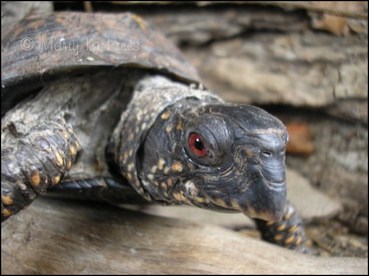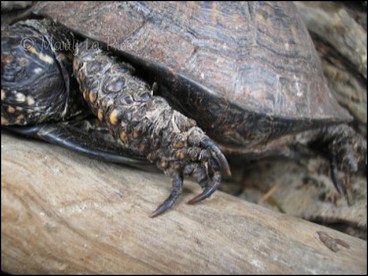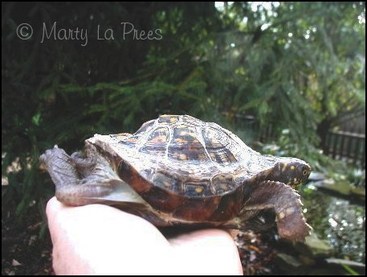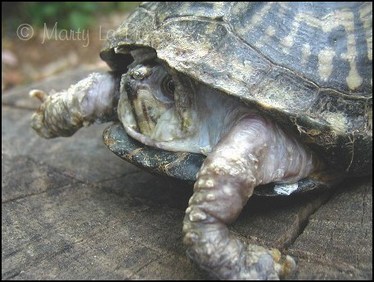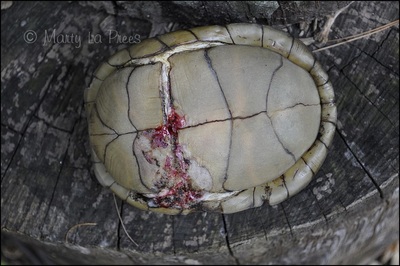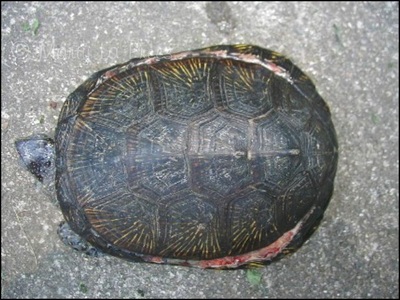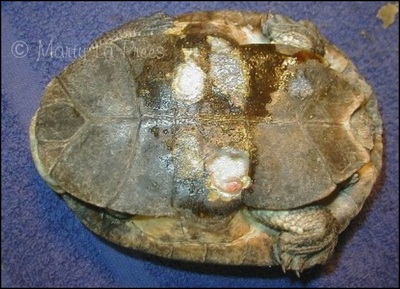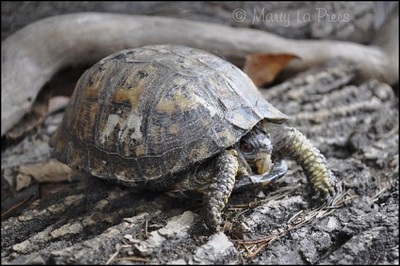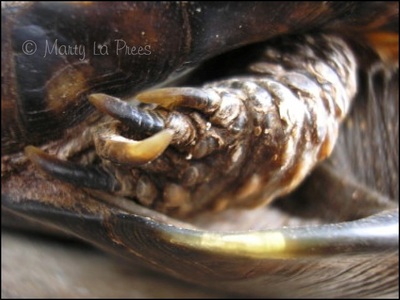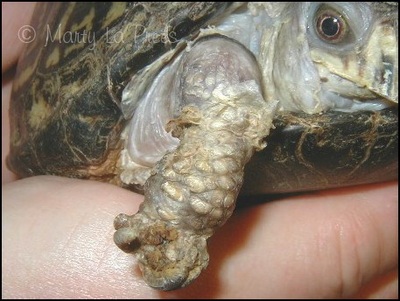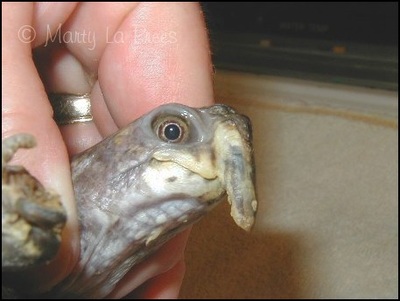Health and Diet
For any serious pet owner, health is one of the number one concerns. Many new turtle owners are surprised to think these
pets can get sick and need veterinarian help. Unfortunately, more often than not, a turtle does not show
signs of illness until it becomes a serious situation. Preventative measures are easy to do to prevent many health problems.
For example, just keeping a box turtle's pen clean, whether it is an inside habitat or an outdoor pen,
can prevent many diseases. When first bringing a turtle home, it is not a bad idea for it to be examined by a
qualified veterinarian who is knowledgeable with reptile care. Providing the proper nutrition is a must when
owning a turtle as a pet. With out proper nutrition, they can suffer severe shell deformities,
debilitating bone growth and organ damage.
Please make sure when owning a turtle or tortoise, they are given the
proper diet and environment they deserve.
DIET AND HYDRATION One of the most important things a turtle owner can do is read, read, read.............and read again,
all the information available for the species you keep. There are many books on care of box turtles.
Box turtles are omnivores, which means they eat both meat and plant foods. Box turtle hatchlings are carnivorous,
meat eaters. Both adults and babies can be considered 'fussy' eaters as they can be difficult and unpredictable.
Much of this has to do with the environment they are kept in. It is wrong to think that a box turtle will eat
when it is hungry enough. A box turtle would rather not eat and die than be in a lifestyle it does not like.
If your box turtle does not eat, remember it could be a health problem as well as an environmental reason. Box turtles
will not eat when they are cool, so they must be allowed to warm up before they are fed. They do respond to
daily routines, as mine can be seen waiting for food at certain times and places in their habitats when outside in the
summer months. The ones that aren't waiting, recognize the sound of the spoon against the side of the
food bowl as I dish out their food for them. They come running from all of their hiding places, with some putting their
noses in the air to smell the menu of the day. The menu varies often, with these being the usual choices:
Mazuri Tortoise Food, Lo fat canned dog food, night crawlers, minnows, crickets, boiled chicken, sweet potatoes,
pumpkin, corn, green beans, tomatoes, carrots, strawberries, cantaloupe, peaches, apples, and grapes.
Reptile vitamins are sprinkled on the food weekly. When the weather begins to cool down, it is not unusual for their
appetites to decrease. In fact, many just don't eat. If that occurs, weigh the turtle often and watch for significant weight loss.
Hydration is at least as important as nutrition in my opinion. If not properly hydrated, the body will quickly
dehydrate and not function properly. They will become very lethargic. Make sure your box turtle has access
to a clean water supply and that it has a humid environment.
pets can get sick and need veterinarian help. Unfortunately, more often than not, a turtle does not show
signs of illness until it becomes a serious situation. Preventative measures are easy to do to prevent many health problems.
For example, just keeping a box turtle's pen clean, whether it is an inside habitat or an outdoor pen,
can prevent many diseases. When first bringing a turtle home, it is not a bad idea for it to be examined by a
qualified veterinarian who is knowledgeable with reptile care. Providing the proper nutrition is a must when
owning a turtle as a pet. With out proper nutrition, they can suffer severe shell deformities,
debilitating bone growth and organ damage.
Please make sure when owning a turtle or tortoise, they are given the
proper diet and environment they deserve.
DIET AND HYDRATION One of the most important things a turtle owner can do is read, read, read.............and read again,
all the information available for the species you keep. There are many books on care of box turtles.
Box turtles are omnivores, which means they eat both meat and plant foods. Box turtle hatchlings are carnivorous,
meat eaters. Both adults and babies can be considered 'fussy' eaters as they can be difficult and unpredictable.
Much of this has to do with the environment they are kept in. It is wrong to think that a box turtle will eat
when it is hungry enough. A box turtle would rather not eat and die than be in a lifestyle it does not like.
If your box turtle does not eat, remember it could be a health problem as well as an environmental reason. Box turtles
will not eat when they are cool, so they must be allowed to warm up before they are fed. They do respond to
daily routines, as mine can be seen waiting for food at certain times and places in their habitats when outside in the
summer months. The ones that aren't waiting, recognize the sound of the spoon against the side of the
food bowl as I dish out their food for them. They come running from all of their hiding places, with some putting their
noses in the air to smell the menu of the day. The menu varies often, with these being the usual choices:
Mazuri Tortoise Food, Lo fat canned dog food, night crawlers, minnows, crickets, boiled chicken, sweet potatoes,
pumpkin, corn, green beans, tomatoes, carrots, strawberries, cantaloupe, peaches, apples, and grapes.
Reptile vitamins are sprinkled on the food weekly. When the weather begins to cool down, it is not unusual for their
appetites to decrease. In fact, many just don't eat. If that occurs, weigh the turtle often and watch for significant weight loss.
Hydration is at least as important as nutrition in my opinion. If not properly hydrated, the body will quickly
dehydrate and not function properly. They will become very lethargic. Make sure your box turtle has access
to a clean water supply and that it has a humid environment.
These 2 eastern box turtles were kept in an environment that was extremely dry with no water source and
non-stop lighting. The skin is thin, pale and peeling.
non-stop lighting. The skin is thin, pale and peeling.
MBD (Metabolic Bone Disease) is a nutritional disorder and is a major cause of mortality in captive bred hatchlings.
The body becomes distorted, the bones of the jaw are soft and weak and the carapace becomes 'pyramided'. Internal organs are also affected by MBD. In some cases, the hind legs are at an unusual angle and it may appear to be taking small steps when walking. This is caused by an improper diet. This is another reason to educate yourself on the needs of your turtle or tortoise.
The body becomes distorted, the bones of the jaw are soft and weak and the carapace becomes 'pyramided'. Internal organs are also affected by MBD. In some cases, the hind legs are at an unusual angle and it may appear to be taking small steps when walking. This is caused by an improper diet. This is another reason to educate yourself on the needs of your turtle or tortoise.
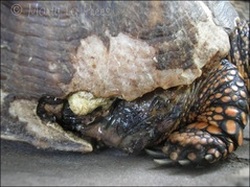 The white-cream colored sac you see in
the photo is full
of maggots.
They are difficult to
eliminate when the
eggs are laid in injuries
that are under the
shell area.
The white-cream colored sac you see in
the photo is full
of maggots.
They are difficult to
eliminate when the
eggs are laid in injuries
that are under the
shell area.
PARASITES One of the most common health issues with box turtles is having
parasites both externally and internally. Most wild-caught turtles will have parasites,
with roundworms being the most common. The intestine is the internal organ that is
usually attacked. There are many reasons for parasite development, with cleanliness
and food being the two most common. Internal parasites can cause various
symptoms: lethargy, dehydration, lack of appetite, and diarrhea. For diagnosis,
a veterinarian will do a fecal float from a stool sample. Medication will then be
given to eradicate the internal parasites. External parasites are much easier to
detect for obvious reasons. They include: ticks, mites, and bot flies.
Ticks need to be removed making sure that you remove the entire parasite.
Mites are a bit more difficult to see as they are very small. Cleaning the turtle's
pen thoroughly and bathing the turtle should take care of the problem.
It should be repeated a week or so later. Bot flies lay their eggs under the skin.
remove the maggots from these flies, you need to remove them with tweezers
then flush the area with Betadyne solution.
parasites both externally and internally. Most wild-caught turtles will have parasites,
with roundworms being the most common. The intestine is the internal organ that is
usually attacked. There are many reasons for parasite development, with cleanliness
and food being the two most common. Internal parasites can cause various
symptoms: lethargy, dehydration, lack of appetite, and diarrhea. For diagnosis,
a veterinarian will do a fecal float from a stool sample. Medication will then be
given to eradicate the internal parasites. External parasites are much easier to
detect for obvious reasons. They include: ticks, mites, and bot flies.
Ticks need to be removed making sure that you remove the entire parasite.
Mites are a bit more difficult to see as they are very small. Cleaning the turtle's
pen thoroughly and bathing the turtle should take care of the problem.
It should be repeated a week or so later. Bot flies lay their eggs under the skin.
remove the maggots from these flies, you need to remove them with tweezers
then flush the area with Betadyne solution.
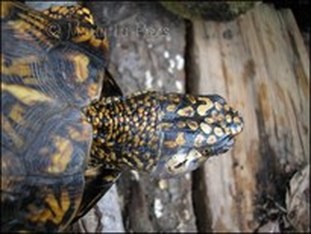
EAR ABSCESS You will know if your box turtle has an ear
abscess as one side of it's face will be bigger than the other.
It appears as a rounded swollen area over the ear area. At times,
the abscesses are on both sides. One of the causes is poor habitat
conditions, either too dry or too wet. With time, it enlarges and
the turtle usually stops eating. Ideally, the turtle should be seen
by a veterinarian for treatment, which includes an incision and
drainage. It is important to make sure all the infection is removed,
followed by a course of antibiotics.
Here at our rehabilitation center, treatment is available.
abscess as one side of it's face will be bigger than the other.
It appears as a rounded swollen area over the ear area. At times,
the abscesses are on both sides. One of the causes is poor habitat
conditions, either too dry or too wet. With time, it enlarges and
the turtle usually stops eating. Ideally, the turtle should be seen
by a veterinarian for treatment, which includes an incision and
drainage. It is important to make sure all the infection is removed,
followed by a course of antibiotics.
Here at our rehabilitation center, treatment is available.
Shell Rot is a fungal or bacterial infection causing pitting, soft spots, fluid under the shell plates, discharge or foul smell, or shell plates falling off and exposing tissue. Too much moisture, too little moisture, unsanitary conditions, improper diet, improper heating, and improper lighting can all lead to shell rot and other ailments. It affects aquatic turtles as well. This must be treated medically and can take a long period of time to heal.
BEAKS AND NAILS Overgrown beaks and nails are very common with captive box turtles. The beak becomes overgrown
when the turtle is given too many soft foods or the eating site is on a soft area. An overgrown beak can prevent the turtle
from eating properly, which would lead into nutritional problems. Putting food on a hard surface is helpful in preventing this.
Nails can become long and/or curled from living in too small of an area. A turtle needs a large area to roam for not only this
reason, but to avoid becoming overweight. Providing areas for a bit of climbing helps to keep the nails under control.
If they are over grown, your reptile vet can trim the beak and the nails.
when the turtle is given too many soft foods or the eating site is on a soft area. An overgrown beak can prevent the turtle
from eating properly, which would lead into nutritional problems. Putting food on a hard surface is helpful in preventing this.
Nails can become long and/or curled from living in too small of an area. A turtle needs a large area to roam for not only this
reason, but to avoid becoming overweight. Providing areas for a bit of climbing helps to keep the nails under control.
If they are over grown, your reptile vet can trim the beak and the nails.
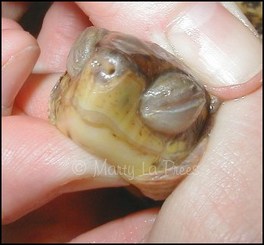
RESPIRATORY INFECTIONS
This is a common illness with box turtles, especially in the winter.
Symptoms are easy to notice. The eyes are closed and puffy, the turtle
is a bit lethargic, and at times there are bubbles out of the nose. Another
way to check is to gently press up on the throat area. If there is a respiratory
infection, often mucus will come from the nostrils. In severe cases, which
develops in to pneumonia, the turtle will stretch its neck out and gasp
in an attempt to clear the airway. If you see these symptoms, you must have
your box turtle treated by a veterinarian. Antibiotics are prescribed.
Keep the turtle warm at 84 to 87 degrees. Some exposure daily to natural
sunlight is beneficial as well. Do not let the turtle get dehydrated.
This is a common illness with box turtles, especially in the winter.
Symptoms are easy to notice. The eyes are closed and puffy, the turtle
is a bit lethargic, and at times there are bubbles out of the nose. Another
way to check is to gently press up on the throat area. If there is a respiratory
infection, often mucus will come from the nostrils. In severe cases, which
develops in to pneumonia, the turtle will stretch its neck out and gasp
in an attempt to clear the airway. If you see these symptoms, you must have
your box turtle treated by a veterinarian. Antibiotics are prescribed.
Keep the turtle warm at 84 to 87 degrees. Some exposure daily to natural
sunlight is beneficial as well. Do not let the turtle get dehydrated.
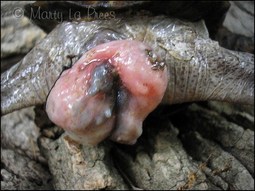
PROLAPSE I have often received a phone call from a box turtle
owner very concerned that 'the turtle's intestines have come out
the back end'. This condition is a prolapse which there are several
causes for this. With male turtles, it can be their penis. Other
considerations would be the colon, the bladder or the cloaca itself.
This must be treated soon after the occurrence to prevent the
tissue from becoming necrotic (dead).
owner very concerned that 'the turtle's intestines have come out
the back end'. This condition is a prolapse which there are several
causes for this. With male turtles, it can be their penis. Other
considerations would be the colon, the bladder or the cloaca itself.
This must be treated soon after the occurrence to prevent the
tissue from becoming necrotic (dead).
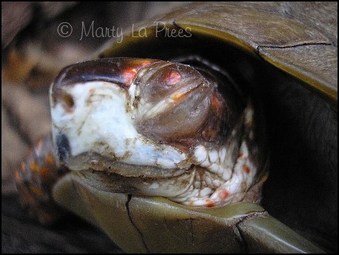
EYE INFECTIONS Habitats that are improperly cared for can easily cause health problems. Eye infections occur due to dryness and/or bad nutrition.
Lack of Vitamin A is a common cause for swollen eyes.
Often the eyes will be covered with a dry material caused
from dried discharge that needs to be removed. A course of antibiotics
is also required for healing.
Lack of Vitamin A is a common cause for swollen eyes.
Often the eyes will be covered with a dry material caused
from dried discharge that needs to be removed. A course of antibiotics
is also required for healing.
